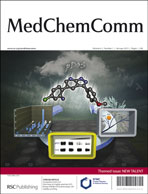Identification of false positives in “HTS hits to lead”: The application of Bayesian models in HTS triage to rapidly deliver a series of selective TRPV4 antagonists
Abstract
Herein, we describe the discovery and optimisation of a series of potent and selective TRPV4


 Please wait while we load your content...
Please wait while we load your content...